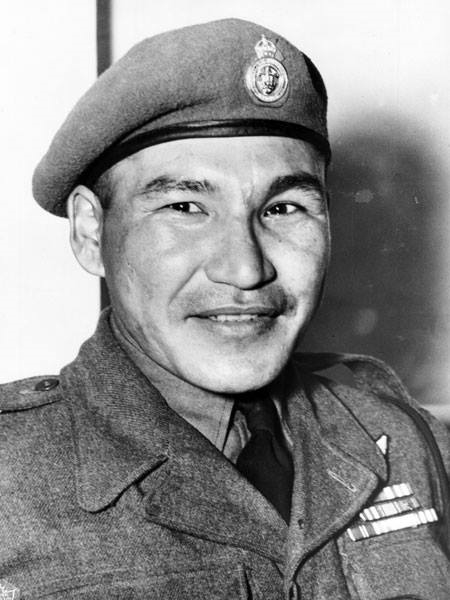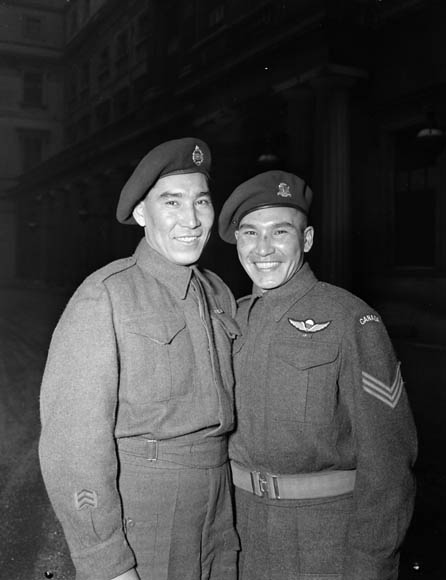This article was published as part of our exhibition on the Italian Campaign: Through Vines and Mines.
Visit our exhibition to learn more about the history of the Canadian soldiers and nurses sent to Italy!
Thomas George Prince was born on October 15, 1915, to the Brokenhead Ojibway Nation in the province of Manitoba. Prince’s family is one of the most important in the region. His great-grandfather, Peguis (later changed to William King after being baptized), led members of his nation into southern Manitoba and signed various treaties with the Canadian government. His son, and Tommy’s father, Mis-koo-kenew (Henry Prince, by baptismal name) later became chief of the nation before his own son, William Henry Prince, took over. Over the years, the Prince family distinguished itself by its strong military tradition. In particular, Peguis earned the nickname “Cut Nose” from a battle wound. Tommy’s uncles and cousins also joined the Canadian army, where they fought against Louis Riel’s Red River Rebellion (1870), in the Nile Expedition to Egypt and Sudan (1885), and in the First World War in Europe (1914-1918).
After graduating from Elkhorn Residential School, Prince worked as a laborer on odd jobs. The economic crisis hit his community hard, and Prince had to put his studies on hold to help his family: “I didn’t want to leave school, but my father had no money”, as he later recounted.
With the outbreak of war in Europe in 1939, Prince tried unsuccessfully to enlist in the Canadian army. However, it wasn’t until 1940, when policies of racial discrimination were relaxed in the face of the pressing need for recruits, that Prince was finally accepted into the army. He was first sent to Great Britain, where he held a clerical position. Completely bored by his duties, he later enlisted in a brand-new unit: the First Special Service Force.
In Italy
Like the rest of his unit, Sergeant Tommy Prince landed in Naples on November 19, 1943. His first mission was to liberate a series of mountains to the east of the peninsula along the Bernhardt Line. It was during these operations that he developed his techniques of reconnaissance and silent marches to approach enemy positions. Throughout December and into early January, the brigade secured mounts La Difensa (hill 960), La Remetanea (907), Camino, Sammucro (1205), hill 720 and Monte Majo, among others.
Monte Majo was heavily fortified by the Germans at the time, but Prince’s reconnaissance skills had already proved their worth in previous battles. On January 8, Prince was commissioned by his officer to lead a night patrol in the mountains to destabilize enemy forces. The elite soldier went beyond expectations. Wearing a pair of moccasins to reduce the noise of his footsteps, Prince moved in the shadows and managed to approach enemy posts and fortifications without difficulty. In complete darkness, Prince manages to neutralize several of the German soldiers undetected, opening up a safe passage for the rest of his unit. Monte Majo was subsequently captured, largely thanks to Prince’s operation.
After Monte Majo, Prince continued to fight along Italy’s west coast, making his way to Anzio. His actions there were perhaps among the most impressive and daring of the entire Canadian army during the Italian campaign. On February 5, 1944, Prince was tasked with a reconnaissance mission to locate German positions in preparation for a new Allied landing. During his mission, the soldier came across a country house near several enemy artillery batteries. Taking refuge there to take notes, German soldiers enter by surprise and force Prince to hide in the attic. For more than a day, the Germans occupied the house, unaware of the Canadian soldier hiding just a few meters away.
On his return from the mission, when his commanding officer thought he was dead, Prince reported enemy positions before being sent back with telephone cables to communicate with his unit. For the next three days, in the midst of artillery exchanges, Prince transmitted enemy positions just a few meters away from German gunners. All this while posing as an Italian peasant, regularly walking around the field, pretending to work in the fields! His courage during this mission paid off when the Allied artillery ultimately destroyed the German guns.
Prince continued to fight at Anzio. There, he built up a fierce reputation among enemy troops. For example, during his reconnaissance missions, Prince makes a habit of leaving messages unbeknownst to enemy troops to indicate his presence. It’s also common for him to go out at night with a sniper rifle to harass enemy positions. Prince’s “little war” later earned him several nicknames from German soldiers: “geist” (“ghost”) and “teufel” (“devil”), in particular.
The First Special Service Force
Nicknamed the “Devil’s Brigade”, the First Special Service Force was created in July 1942 by the US Army with a view to possible combat in Arctic environments. In fact, it was initially agreed that the unit would comprise American, Canadian and Norwegian soldiers, given their habitual acclimatization to the cold. Nearly 700 Canadian officers and soldiers were recruited and sent to Italy on November 19, 1943, for their first major operation. First sent to the island of Kiska as part of the Aleutian Islands campaign, the troop then moved on to Italy on November 19, 1943, for their first major operation. In Italy, the soldiers specialized in mountain operations, where they had to dislodge German and Italian defenders in long, arduous battles. With a 77% loss rate in 1943 alone, the unit suffered considerable damage. Despite this, its exploits remained undeniable, and the brigade became an important force in the liberation of the peninsula. Finally, on August 14, 1944, the unit was transferred to France, before being disbanded in December of the same year.
After the Italian campaign
As the Germans and Italians ceded ground to the Allies in Italy, it was decided that the Devil’s Brigade would be more useful in France, where the fighting was still raging. On September 1, 1944, Sergeant. Tommy Prince carries out one of his most daring actions yet. A year after the Kiska landings, Prince and the joint US-Canadian First Special Service Force are now on the other side of the globe, having landed in southern France as part of Operation Dragoon.
That day, Prince and his reconnaissance partner trekked 24 kilometres behind enemy lines with the aim of scoping out German outposts, gun emplacements, and camps. On their way back through the mountainous terrain, they came across a squad of Free French Partisans (FFP) that were being surrounded by a German platoon.
The math certainly didn’t favour the Partisans, who were probably outnumbered three or four to one. It’s difficult to see how a mere two men could change these odds.
But that didn’t stop Prince and his private. Taking up sniping positions, the two of them started picking away at the Germans, with Prince killing six and injuring more. Shocked by the sudden and high casualties all around him, the German commander called for his troops to retreat, leaving behind the FFP.
After greeting the Partisan leader, Prince was asked where the rest of his troops were. He replied, “Here,” pointing at his partner. The French officer was shocked: “Mon Dieu! I thought there were at least fifty of you!”
Two days later, Prince and the group returned to the US-Canadian lines and successfully delivered the gathered intelligence to their command. Walking some 80 kilometres over the last five days, he was credited with ensuring the smooth advance of the Devil’s Brigade on September 5. For this deed, Prince was awarded the US Silver Star. Combined with his reception of the Military Medal, this put him in the elite company of only two other Canadians.
Highlighting the disparity between Indigenous Peoples and non-indigenous people in Canada, Prince’s post-war veteran’s benefits were far from the same standard provided to the latter. Much as Corporal Pegahmagabow of the previous generation, he encountered significant difficulties in trying to carve out a role for himself in civilian life. Although he ran a successful cleaning company for a short time, he realized this was a poor position from which to advocate for greater Native Canadian respect in the country.
But before much could be done in that regard, the Korean War began and the call to arms once again attracted Prince, who immediately joined the newly-raised 2nd Battalion of the Princess Patricia’s Canadian Light Infantry (PPCLI). Although he performed and led magnificently, including at the Battle of Kap’yong, a severe case of arthritis in his knee resulted in him being sent home to carry out training duties. Hardly content with this role, he loudly and frequently complained about wanting to go straight back into battle. He soon got his wish, joining the 3rd PPCLI in October 1952. But battle exhaustion accumulated since the Second World War put him out of action once more and he was discharged back to Canada.

His last years
Throughout his military service, Prince was quick to emphasize his native origins: “All my life, I had wanted to do something to help my people recover their good name. I wanted to show they were as good as any white man”. Like many indigenous people in Canada, Prince was a victim of racism all his life: from his studies at residential school, to his first attempts to enlist, to his professional career after the war. Indeed, regardless of his service to Canada, he faced constant discrimination from non-indigenous at the workplace. The uniform, however, offered him an immeasurable source of pride and validation.
Though never formally diagnosed with it, he definitely exhibited signs of Post-traumatic Stress Disorder (PTSD). In the 1950s there were no attempts at addressing this issue. Like many veterans, Prince fell victim to a system and a society that had little understanding of mental illness. In fact, he was granted very few resources because of his native status, and for one reason or another, Prince was not fortunate enough to enjoy solid support from his home regiment. Living in poverty, the veteran took refuge for a long time in self-medication to soothe his many physical and psychological wounds. Finally, after many years, he died in 1977 at the Deer Lodge Hospital for Veterans.
Today, Tommy Prince is best known for his impressive feats of arms in Europe and Korea. To this end, his former comrades were quick to point out his constant efforts at the front. Prince was a man made for the military life, but this life has a strong backlash for this type of person. As historian P. Whitney Lackenbauer aptly described in his own biography of Tommy Prince: behind every hero lies a fallible person. Prince did not deviate from this rule. While it’s important to highlight his service, it’s equally important to emphasize his difficult life after the war. Prince’s story at the front is impressive, but his story after the war is unfortunately emblematic of that of many veterans, native and non-native alike.
May his service and sacrifice never be forgotten.
Cover photo: Sergeant Tommy Prince and company receiving direction from their commander, March 21 1951 (credit: OttawaCitizen.com).
Re-printed here with the permission of Valour Canada as part of a collaboration between JMS and Valour Canada. To see more articles like this one, check out their Military History Library. Update October 23, 2023: text modified and enhanced by Julien Lehoux for Je me souviens.
For more information:
- To learn more about Tommy’s life and service during the Second World War, visit Canadiana and Veterans Affairs.
- You might want to read “Tommy Prince, the decorated and forgotten war hero“, Ottawa Citizen, September 30, 2017 edition.
- For a more academic approach, see “Tommy Prince: Warrior” (Canadian Military History, V16:2).
- Finally, we invite you to consult the in-depth bibliography by historian P. Whitney Lackenbauer: ““A Hell of a Warrior”: Remembering Sergeant Thomas George Prince“.



